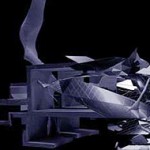Written By Andy Loeshelle
A – Professor, thank you for taking the time to speak with me. I know that you have been busy for the past 5 months on the light pavilion project. I’m sorry to hear that Lebbeus Woods has passed away. I know that he was an inspiration to you, and ever since your course at Pratt, I have drawn inspiration from him, too.
C – Your words are very kind. Yes, he is, and will always be an inspiration for me. I have worked with him for many years and the quality and quantity of his creative genius is far beyond what most people in our field [architecture] have today.
A – What are some of your other inspirations when you design?
C – My inspirations literally come from everything: the air we breathe, the books I read, my education, and the architecture that I have seen throughout my lifetime.
A – What is your educational background?
C – I have been working on pursuing an architectural education for as long as I can remember. My true architectural dreams began when I was a child playing with simple tools such as sticks and different building materials such as paper and thread. Through my secondary education, I took every design course offered. I took classes in every discipline and with every teacher so that I could learn from every discipline and understand the visions of every teacher that taught each class. From my secondary education, I went to university in Vienna at the Vienna School of Architecture, where I applied myself rigorously. I overloaded on my courses and took far more than I should have. In hind sight, I didn’t have much of a social life. The majority of my time was spent reading, studying, dreaming, and thinking architecture. It was as much a part of who I was as the air that went through my body. From Vienna, I moved around and began teaching at Cooper Union in New York. I found that the majority of my architectural education didn’t come from being taught, but rather from teaching. The students that I have had, including you, have all given me new perspectives on architecture. The ideas and concepts that arise from your minds are amazing and it is incredible to see the new ideas that are presented with each assignment.
A – Do you ever regret choosing architecture as a career path?
C – In a word: never. Architecture is so much a part of my life that anything that I ever do, or think about, I translate into my discipline.
A – Can you give an example of this philosophy?
C – An example would be the book project that I had you do. [At my summer course at Pratt, Christoph made us take a book and manipulate it physically to create an architectural structure] I take the natural and created world around me and use it to create architecture. It is not so much the possibility of creation, but rather the possibility of experimentation and discovering the limits of one’s own creativity.
A – So, when you design buildings, what methods do you primarily use? Do you use such methods as the book method that we used or do you design more systematically with materials?
C – To tell you the truth, I do a combination of these things. I tend to focus on the physicality of the project first. Firstly in the layout of the perspective construction site, secondly in the topography, thirdly in the concept of movement. I also use different methods such as the book design method and using different materials in small scale. I mentioned before that, as a child, I would work with paper and thread. I still use this method. It is incredible how many designs one can create with a piece of paper and some thread. You should also try this method. Even a piece of crumpled paper can be an inspiration for one’s architecture.
A – What is it like working as an architect?
C – It is very difficult unless you are very good. I am blessed in the connections that I have made over the years, but the majority of architects rely on competitions. Companies will come out saying that they require someone to build a structure for them, or a headquarters, or something along those lines. They will then hold competitions in which private companies and architects fight for the rights to the project. It’s a long difficult process that leaves you bloodied and torn and your ideas often mangled. You go in with an idea and they ask you for more and more until your project looks nothing like it originally had. Then your idea is entirely thrown out and they accept someone else’s design.
A – Do you ever reuse architectural models for different competitions?
C – It is simply not done. You must go into each project looking for new inspirations to suit the parameters laid out for you.
A – What skills do you believe are the most important for being an architect?
C – There are two skills that all architects should have. First is the ability to imagine. The more one reads, writes, and thinks, the more he imagines. Dreams are imaginations, doodles are imaginations, bending a paperclip is imagination. Your imagination can lead to inspirations that can greatly influence the span of your work. The second skill is experience. Absorb all that you can. Whether it is reading about architecture or just something fictional or non-fictional it builds on your experience. Also, eat, sleep, dream, and think architecture. Anything that you do can build on your experience. Now, and even as a student, I would attend every lecture I could, whether it was about architecture or not, it still added to my experience.
A – If you had to describe your architectural process in one word, what word would you use?
C – This is quite difficult. If I had to choose, which is what you are making me do, I would say “learning”. You must always build upon the knowledge that you have compiled. Take ideas and let them fully mature. Not only should you use and reuse ideas until they are perfected, but you should always build off of ideas. A line can become curved, a curved line arched, an arched line into an spiral, and a spiral into some other fantastic shape that is only limited with ones creativity.





